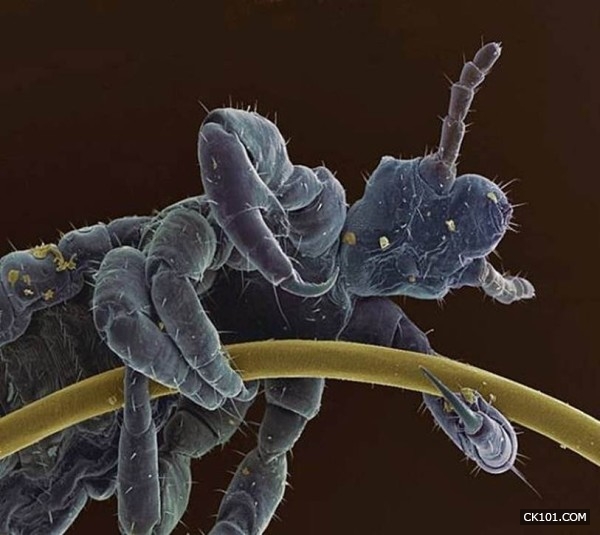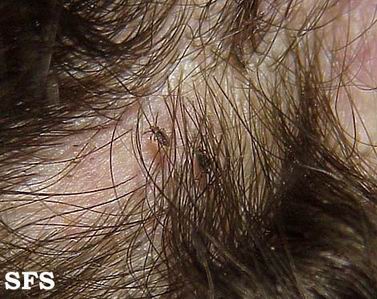
There has been a growing concern that head lice are becoming resistant to some common over-the-counter treatments.
July 26, 2010 -- There is little else that triggers such a visceral reaction from parents than the words "head lice ," especially when they are uttered in conjunction with an outbreak in their child's classroom or summer camp.
But when it comes to these creepy, crawly, head-dwelling creatures, there is nothing to fear except fear itself, say researchers in an updated report on the diagnosis and treatment of head lice in the August issue of journal of Pediatrics.?
Yes, head lice are gross, but they are not a health hazard or a sign of poor hygiene. They don't spread any disease, and controversial no-nit policies, which state that if your child has any sign of lice or their eggs (nits) they should be kept home, should be abandoned, they say.
"It's only a bug on your child, not in your child like the flu or pneumonia ," study author Barbara L. Frankowski, MD, MPH, professor of pediatrics at the University of Vermont in Burlington, says in an email. "Healthy children -- which includes children with head lice infestation -- should be in school learning."
Treatment-Resistant Head Lice
The new report was last updated in 2002, and since that time, there has been a growing concern that lice are becoming resistant to some common over-the-counter treatments such as permethrins (like Nix) and pyrethrins (like A-200, Clear Lice System, Pronto , R & C, and Rid).
"They are still a good first-line treatment for most since they have been proven to be so safe and are available over the counter, [but] if these products don't work and you are sure you have the correct diagnosis and have used the product properly, then you would want to talk to your health care provider about second-line prescription medications," Frankowski says.
Another option is wet combing with a fine-toothed lice comb to make the lice easier to catch and remove, or suffocation (petroleum jelly or another product is massaged into your child's hair, he or she wears a? shower cap overnight and doesn’t wash their hair until the morning).
"Wet combing and suffocation methods are more time consuming, but can be helpful for parents who wish to avoid chemicals," she says.? "None of the methods are 100% effective, and often need to be repeated for two or three cycles," she says. This includes nonprescription products.
There are some newer treatments available that target lice that have developed resistance. "There are several prescription options like Ulesfia, Ovide , ivermectin , and your health care provider can help you weigh the risks and benefits for your child," she tells WebMD. While effective, these treatments may have some risks attached to them, and need to be studied for longer periods of time. Another prescription product used to treat lice is lindane shampoo (Kwell).
Diagnosing Head Lice Is Tricky
Diagnosis of head lice is not a slam dunk, and misdiagnosis of head lice may play a role in treatment? resistance, says Cindy DeVore, MD, a pediatrician and school physician in New York State and the chair-elect for the Council on School Health of the American Academy of Pediatrics.
"Parents may misdiagnose head lice when they see flecks of dandruff or debris and mistake it for head lice in the face of a classroom parent notification?of lice," she tells WebMD in an email. "Because self-treatment has been available, involvement of physicians in the care of a child with head lice tends not to occur, and overuse and misuse of OTC medicines?likely have complicated sorting out what is actual resistance and what is simply inadequate, inappropriate, or under-treatment."
Treatment should only be started if there is a clear head lice diagnosis, she says.
Bernard Cohen, MD, chief of dermatology for Johns Hopkins Children's Center in Baltimore, agrees.
"Despite resistance to treatment, I think the most common cause of spread and treatment failure is failure to identify and effectively treat all infested kids."
Preventing Lice Not Easy Either
So if diagnosis is tricky, and lice are starting to outsmart some of the more common treatments, what about prevention?
Lice can't hop or fly. Instead, they crawl from head to head.?"Totally preventing head lice is probably impossible, if you have a normally active, social child," Frankowski says. "Head lice is a normal risk of childhood, just like colds and scraped knees."
"Although most lice infestations are spread by direct head-to-head contact, many advise teaching children not to share combs and brushes," she says. That is OK, but "not using helmets for safety because you are afraid of lice is never an option," she says.
"Most cases of head lice are community acquired, often at sleepaway programs or parties, and not uncommonly in the summer," Devore says. "Parents should do regular surveillance of young children, checking the napes of necks,?behind ears, and throughout the scalp, looking for signs of live lice or "nits" cemented to hair shafts close to the scalp that are not readily pulled out," she says.
And "if there is a significant outbreak in a classroom of more than 20% of the children, the parent can check with the primary care physician to see whether use of a permethrin rinse on an uninfested child?might confer some protection until the infestation in the classroom calms," she says.
Not All In Favor of No-Nit Policies
Although the researchers do stress abandoning no-nit policies to avoid prolonged, unnecessary absences from school, other organizations, including the National Pediculosis Association, still support them. The nonprofit group states that not removing nits is the main reason treatments don't work, and if children with hatching nits are readmitted to school, the head lice outbreak will continue.
"While absence from school or child care is a loss of educational opportunity and an encumbrance to working parents, readmitting an infested child is not the solution," the group states. "A policy for head lice must consider not only the infested child, but also his or her peers who have already been successfully deloused or who have not yet been infested."
WebMD Health News
by Denise Mann
Reviewed By Louise Chang
【24drs.com】July 26, 2010 – 沒有什麼字比「頭蝨」更會引起父母親的本能反應了,特別是小孩的班上或夏令營發生全體爆發時。
研究者在8月號小兒科(Pediatrics)期刊有關頭蝨診斷與治療的新版報告中指出,對於這些寄居在頭上令人頭皮發麻的小生物,令人恐懼的只有恐懼本身。
他們表示,是的,頭蝨很嚴重,但是它們對健康沒有危害、也不代表衛生不好,它們不會傳播疾病,而有所爭論的「無蟲卵政策」:如果你的小孩有任何頭蝨或卵的徵兆應待在家中,則應被廢除。
研究作者、伯林頓佛蒙特大學小兒科教授Barbara L. Frankowski醫師在電子郵件中表示,那只是你小孩身上的一隻蟲,不是你的小孩罹患流感或肺炎,健康的小孩— 包括感染頭蝨的小孩—應到校上學。
【阻抗治療的頭蝨】
新報告前一次的更新是在2002年,自此之後,越來越多人擔心頭蝨會對permethrins (如Nix)和pyrethrins(如A-200、Clear Lice System、Pronto、R & C、和Rid)等成藥產生抗藥性。
Frankowski醫師表示,仍有一些安全而有效的第一線治療用成藥,但是,如果這些產品沒有效,而且你確定你有正確的診斷且適當的使用該產品,那麼你應該向你的健康照護者詢問第二線處方藥物。
另一個選擇是用細齒梳濕濕的梳頭髮,可以更容易抓住和除掉頭蝨,或者用窒息法(用凡士林或其他產品按摩小孩的頭髮,然後讓小孩戴上浴帽整夜,直到隔天早上才洗頭)。
她表示,濕梳法和窒息法更耗時,但是有助於家長避免使用化學藥品的希望。沒有哪一種方法是100%有效的,通常需要重複兩、三個療程,包括一些非處方產品也是。
有一些針對頭蝨的新治療方法已經產生抗藥性。她向WebMD表示,有許多處方選項,如Ulesfia、Ovide、ivermectin,你的健康照護提供者也可以幫助你衡量對小孩的利益與風險。除了有效之外,這些治療可能對他們有一些風險,需要更長時間的研究。其他用來治療頭蝨的處方產品如lindane洗髮精(Kwell)。
【頭蝨診斷是需要技巧的】
美國小兒科學會、校園健康委員會主席候選人,紐約州小兒科醫師、校園醫師Cindy DeVore表示,診斷頭蝨並不是灌籃,誤診是造成治療阻抗性的主因。
她在電子郵件中向WebMD表示,醫師看見頭皮屑或碎片時可能誤診為頭蝨,向該班家長宣布有頭蝨。因為現在有自我治療,比較不會就醫為有頭蝨的小孩尋求照護,濫用和誤用成藥可能會造成處理上的複雜性,較難確認實際的阻抗性,或者只是治療不適當、不相符合或治療不足。
她表示,只有在明確頭蝨診斷時才開始治療。
約翰霍普金斯兒童醫學中心皮膚科主任Bernard Cohen醫師表示同意。
不管對治療的阻抗性,我認為擴散和治療失敗的最常見原因是,無法對所有受感染的小孩進行確認和有效給予治療。
【預防頭蝨也不容易】
那麼,如果診斷是具有技巧性的,而且頭蝨開始對一些常見治療有抗藥性,預防的情況又是如何呢?
頭蝨不會跳也不會飛,它們是從一個頭爬到另一個頭上。Frankowski醫師表示,如果你有一個正常好動、社交正常的小孩,完全預防頭蝨幾乎是不可能的,就像感冒和跌倒造成膝蓋擦傷一樣。
她表示,雖然多數的頭蝨感染是因為直接的頭對頭接觸,許多人會建議小孩不要和別人共用梳子和刷子,這是可行的。因為擔心蝨子而不使用安全帽,則是不可行的。
DeVore醫師表示,多數頭蝨案例是社區型的,通常是在住宿營或宴會中,在夏天常見。父母親應定期檢查小孩的後頸、耳後和整個頭皮,看有無蝨子或髮根上有尚未孵化之蟲卵的徵兆。
她表示,如果班級有超過20%的孩童發生,家長可以找主治醫師,看是否要對尚未感染的小孩使用permethrin 洗滌,可能可以有一些保護作用,直到班級疫情平息。
【並非所有人都贊成無蟲卵政策】
雖然研究者強調放棄無蟲卵政策以避免學校之不必要的延長停課,其他機構如國家疥癬協會依舊支持。這個非營利組織表示,治療無效的主因是蟲卵沒被排除,如果身上有孵化中的卵的小孩再度上學,就會繼續爆發頭蝨。
該團體指出,雖然停課或停止孩童照護是教育機會的損失且造成有工作之家長的困擾,但是讓有感染的小孩上學也不是解決之道。有關頭蝨的政策除了考量受感染的小孩,也要顧及他已經成功滅蝨和尚未感染的同儕。
有看過頭蝨嗎?



不要以為只有頭髮會長頭蝨哦,

這是睫毛蝨的特寫:






 留言列表
留言列表
 線上藥物查詢
線上藥物查詢 